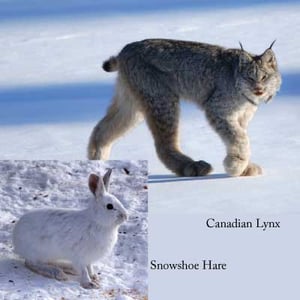
With the use of modern technology, navigating in the snow is much easier today than it has been for most of human history. Snow plows, snow blowers, and shovels allow us to quickly remove copious amounts of snow and continue on with our daily lives. However, life in the snow wasn’t always this easy. Imagine a storm drops 20 inches of fresh snow and your only means of travel is by foot. This is a major challenge! Humans’ initial invention to combating this challenge was finding a way to float on top of the snow’s surface: snowshoes! Although today they’re mostly used for recreation, snowshoes were one of people’s key tools for surviving the harsh, snowy winters. Snowshoes provide flotation on top of the snow because they distribute your body weight over a larger surface area. This is the same reason that wide powder skis can help us float on the snow’s surface after a big snow storm. Today’s snowshoes are made with aluminum, but the primitive invention was just a wood plank and a strap. Anthropologists hypothesize that snowshoes were first invented about 6,000 years ago in Central Asia. It is likely that these wooden plank snowshoes were used to cross the Bering Land Bridge into North America. Since then, people have been using them to traverse through all types of snow conditions. But where did the inspiration for snowshoes come from? We can find answers by turning to our counterparts in nature.
Snowshoes are a great example of biomimicry, which is when humans design products and materials based on nature. Humans have adopted this snow-flotation device from our furry friends in the wild. Several animal species right here in Eagle County have special adaptations for voyaging through the deep mountain powder.
Canadian Lynx are distinguished from other cats by their giant, furry paws. Although disproportional to their body size, these massive paws allow for the lynx to distribute their body weight over a larger surface area, just like our man-made snowshoes. Having these large, snowshoe-like paws helps the lynx chase down its prey in the winter, even in the deep, loosely packed snow of subalpine forests.
Next, we’ll discuss the eponymous character, the Snowshoe Hare. As you may have guessed, this furry mammal is named after its advantageous adaptation for navigating the snow; it’s large hind feet. The snowshoe hare happens to be the main source of food for lynx among other predators, so it must be able to move quickly through deep snow. The snowshoe hare is difficult to see due to its camouflaged fur, however, you can easily spot their unique tracks from their large feet in the snow throughout the local subalpine forests.
Another local critter with keen adaptations to the snow is the Ptarmigan. The ptarmigan has foot feathers that act as thermal insulators and distribute their body weight over a larger surface area, allowing for flotation. The large feet of the Ptarmigan are especially advantageous because their main habitat is in the alpine at or above treeline, where the snow can be very deep.
These Colorado animals have learned the advantage of having large feet in the winter. These large, fluffy feet are a key adaptation for survival in the deep mountain powder. Luckily, we humans have created technology to help us combat this winter challenge, but we can still use snowshoes for recreation. If you enjoy snowshoeing or are interesting in trying it out, consider joining us for one of our snowshoe programs! We offer guided backcountry hikes every Tuesday and Thursday and hour long hikes daily. Perfect for those seeking a tranquil winter experience far from the ski slopes, these hikes offer the perfect introduction to winter backcountry exploration. Learn more about these programs on our website, www.walkingmountains.org.
Meredith Grupe is a naturalist at Walking Mountains Science Center. She enjoys hiking, skiing, and singing in her free time and loves the Colorado Rockies.








